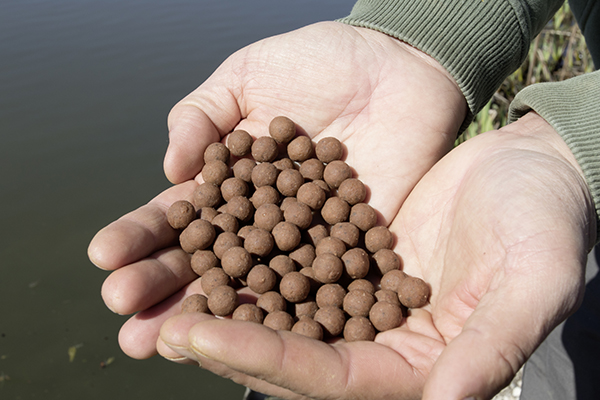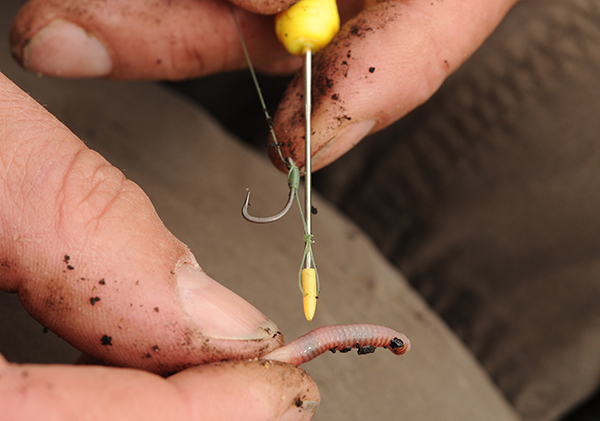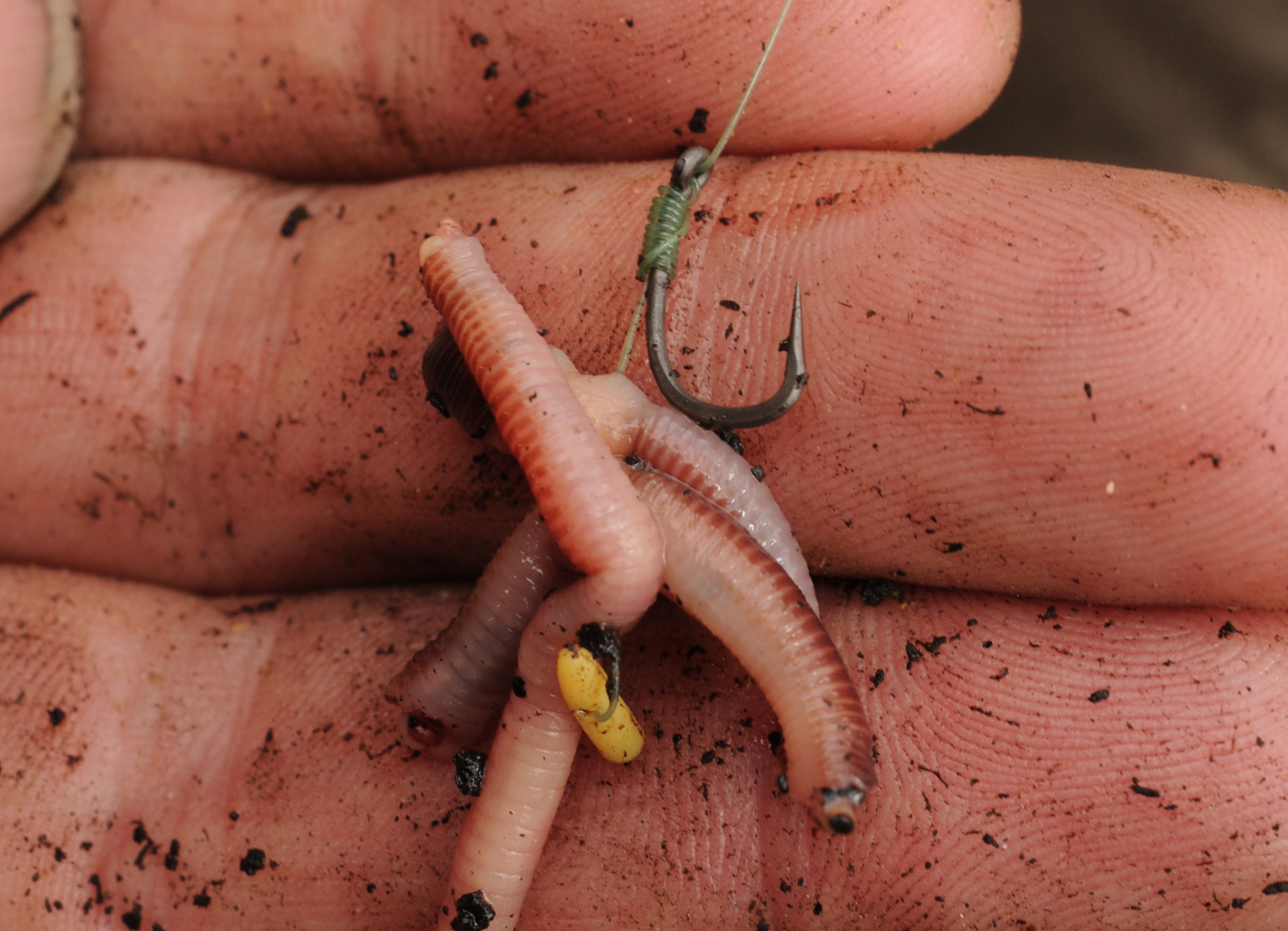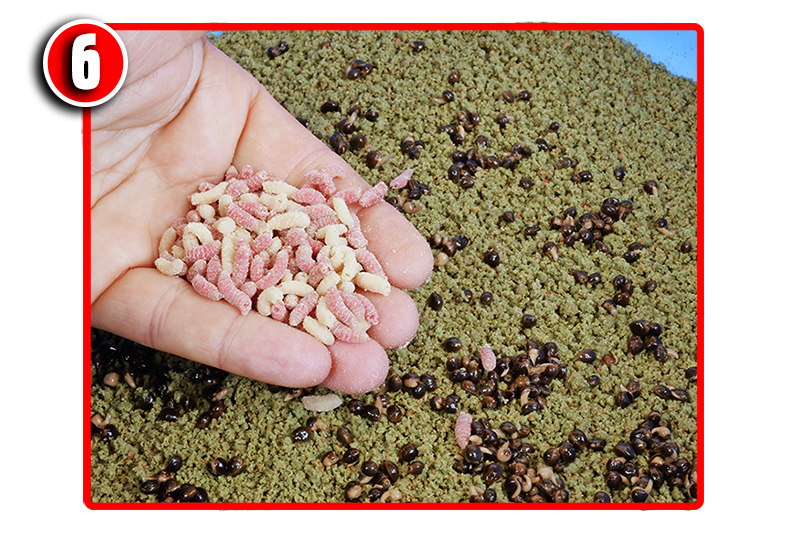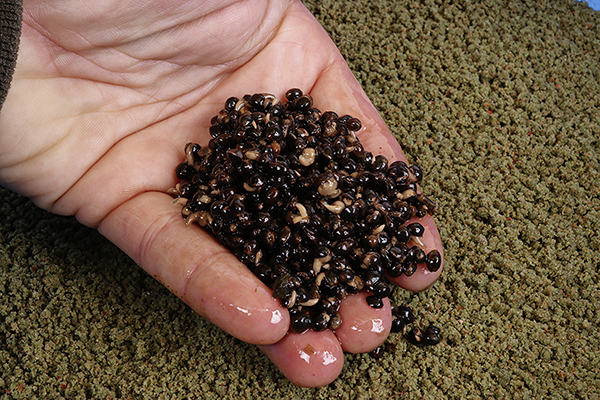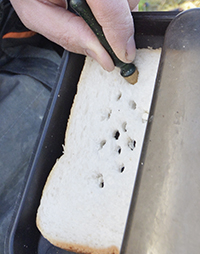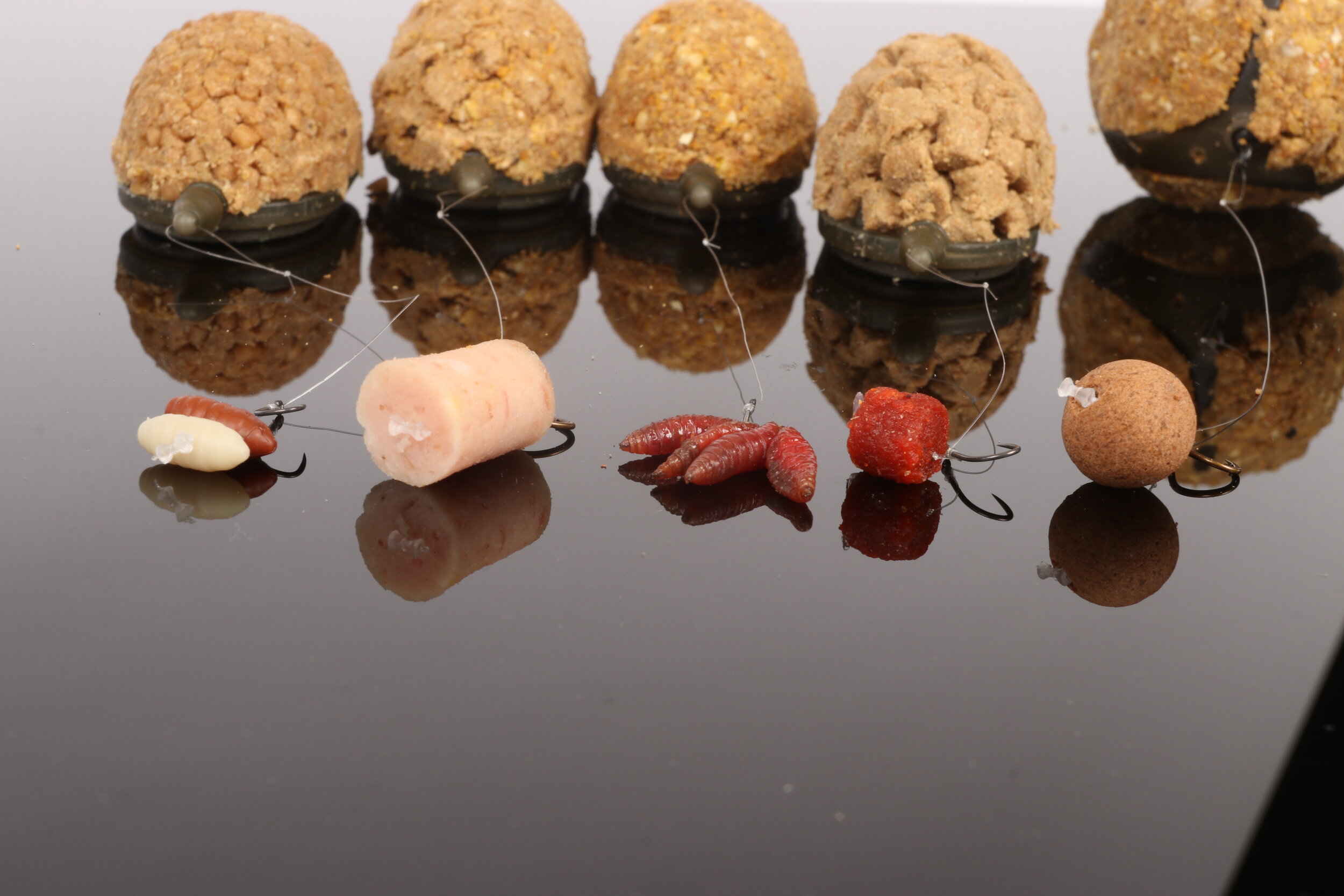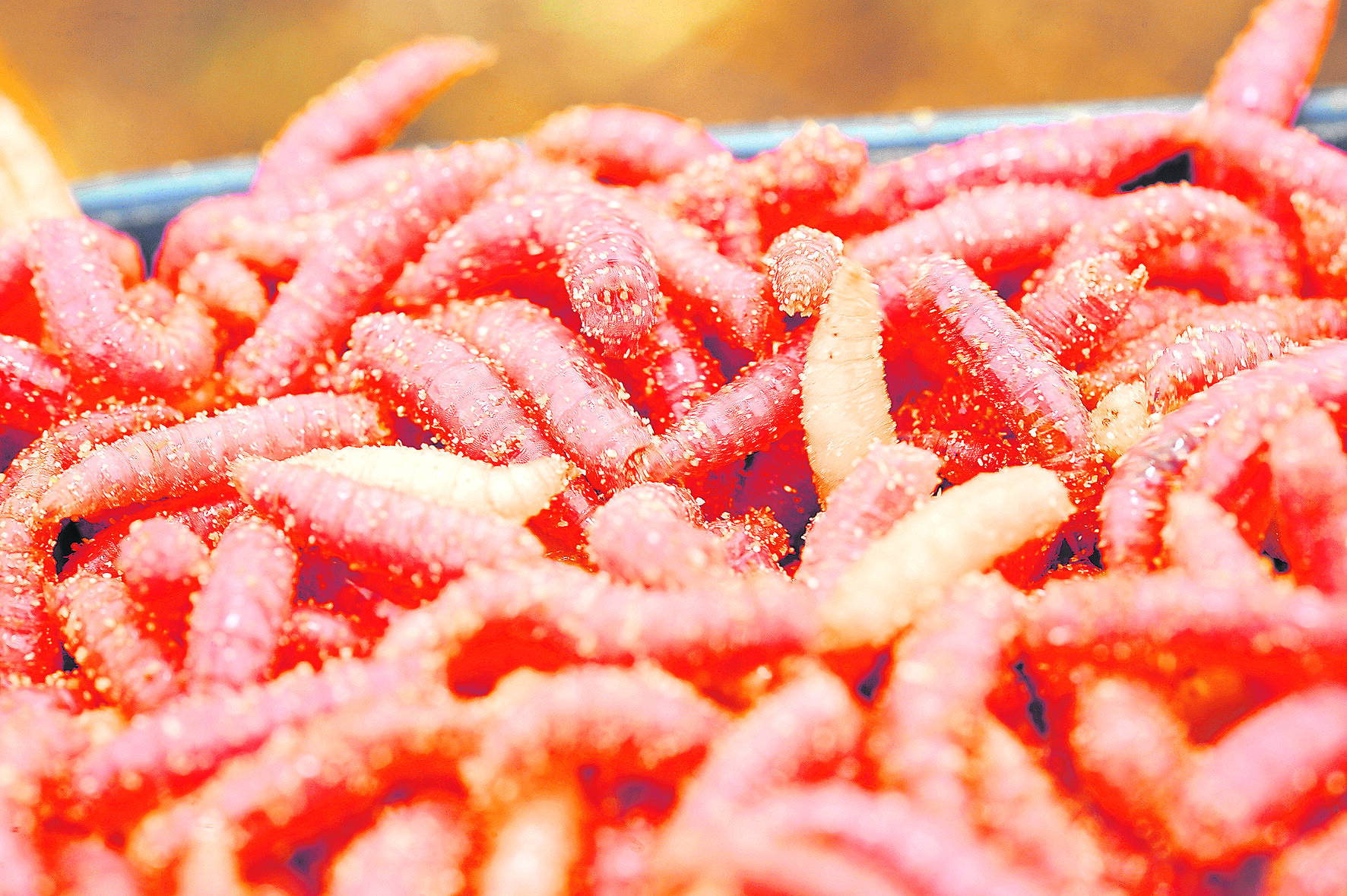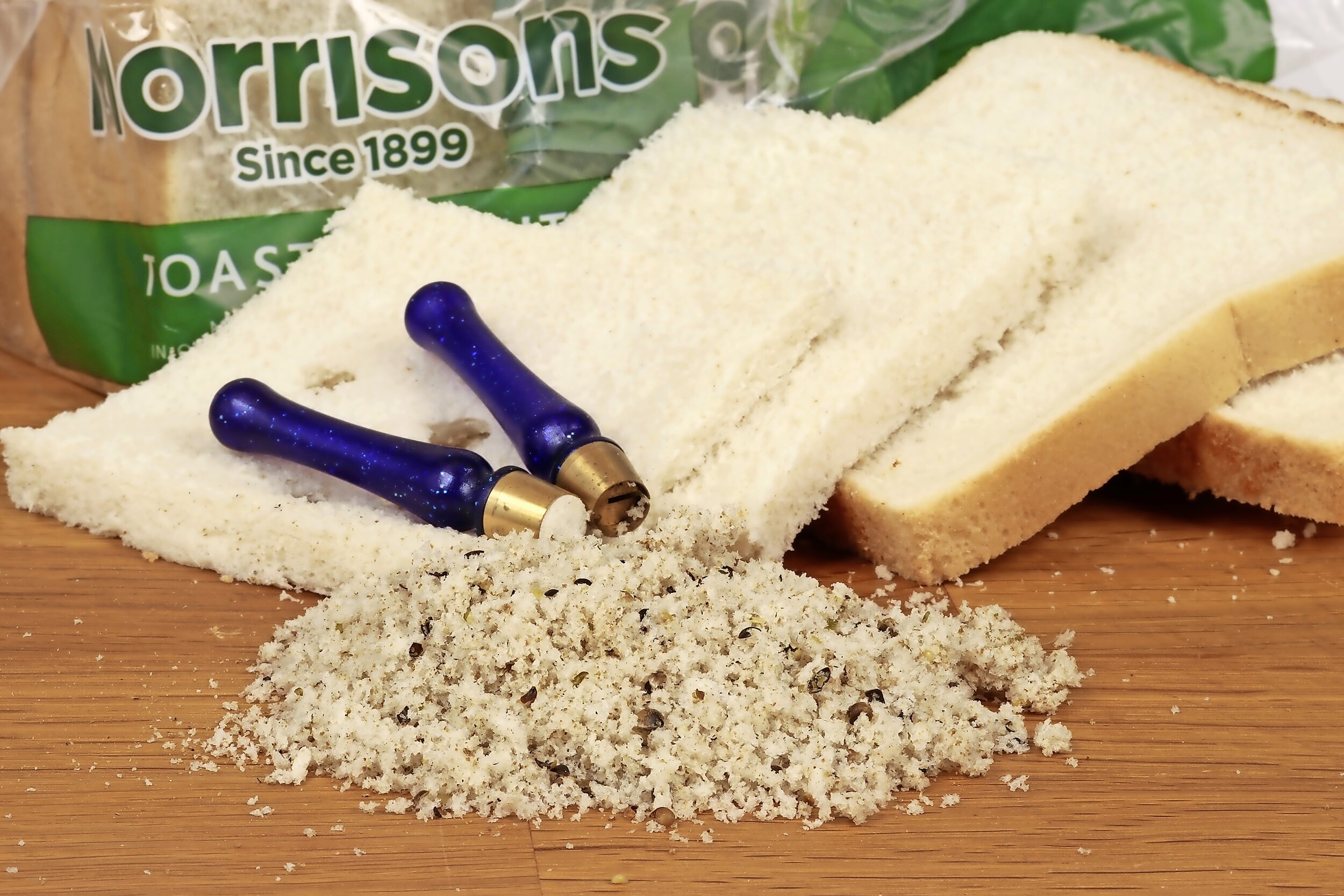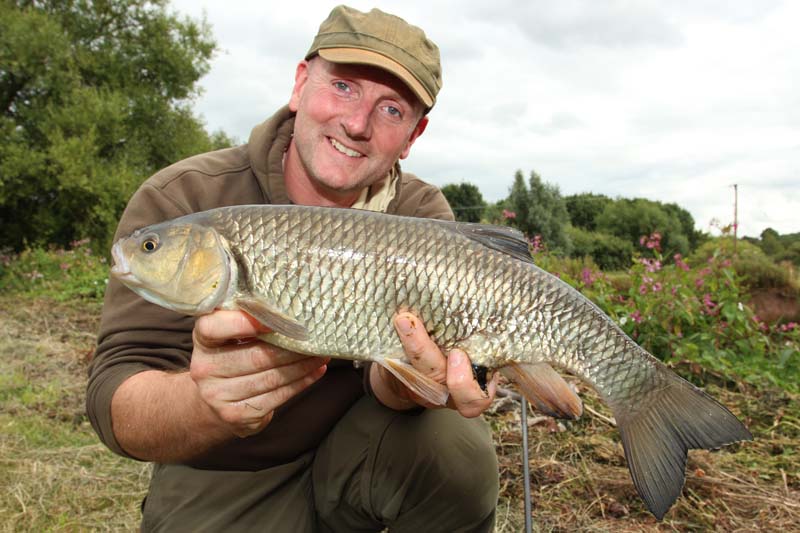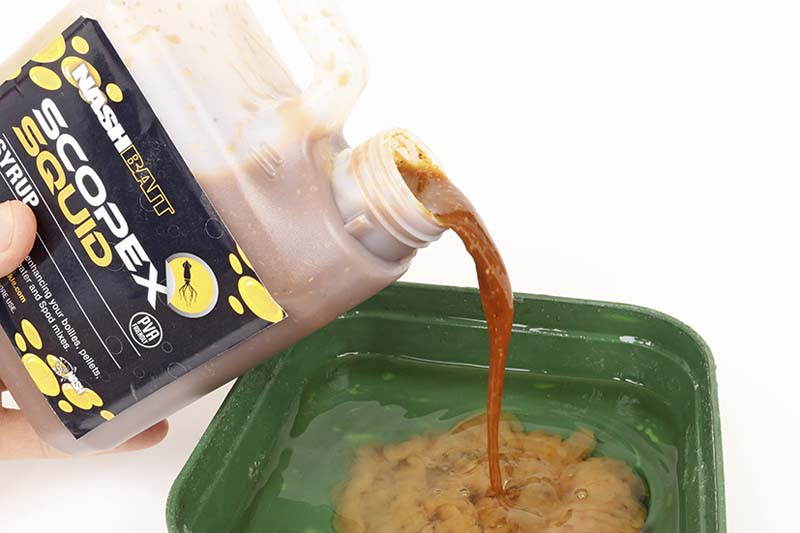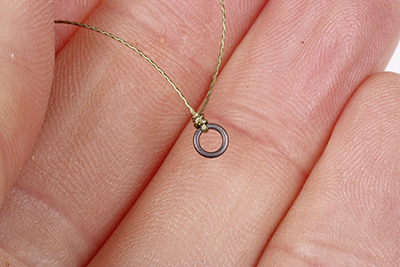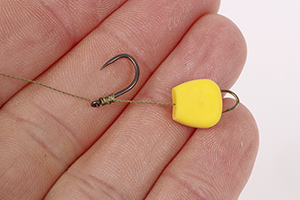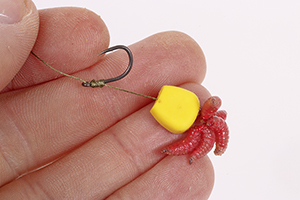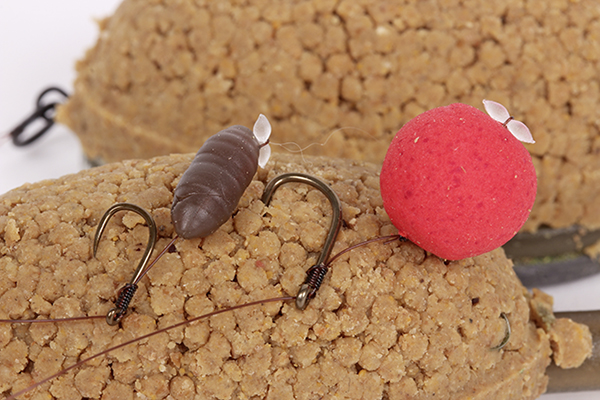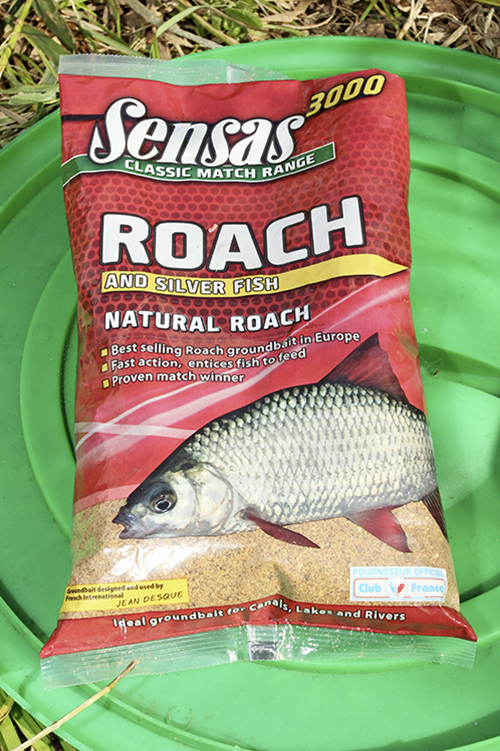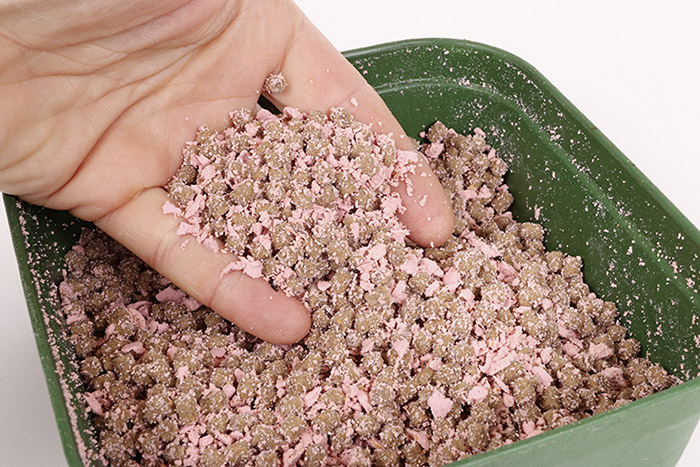The best bream fishing bait mix
Two-time Drennan Cup winner Dai Gribble reveals what his favourite bream fishing spod mix is. Take a look at the four steps below and try it out for yourself next time you're out on the bank bream fishing.
1) My feed is made up of a mixture of Sonubaits fishmeal and bread-based groundbaits. I will use Supercrush Bream Feeder as a base for the mix but will darken this off with Super Crumb Black Bream. You can make the mix even stickier by adding Super Crumb River to it, and this helps when you’re making long casts on the Method feeder.
2) The groundbaits are blended together first and then are mixed up with lots – up to a pint – of liquid molasses. Molasses is quite dense and very soluble, and a trail of it will leak off the groundbait in the undertow, pulling bream from a long distance.
3) The crumb is supplemented by a mix of Pro Feed and S-Pellet Feed Pellets in 2mm and 4mm sizes – great for keeping fish in the swim for longer – plus a couple of tins of F1 sweetcorn.
4) I also add a small number of the boilies that I use for hookbaits. The critical thing is not to introduce too many of the high-attract baits as free offerings. You want enough for the bream to get a taste for them and hunt them out, but not so many that it reduces the chances of them taking your hookbait.
Generally, I add no more than about 30 boilies, whilst using up to five kilograms of groundbait and pellets.
The best hookbait to use when fishing.
Paul Garner explains what his favourite hookbait is and what makes it so perfect.
What makes the perfect hookbait? Mine would need to have the right texture, breakdown speed and buoyancy. It would be easy to hook, of a perfect flavour and colour, and I’d want to be able to change the size and shape quickly.
That’s a big ask, and most baits fall down on one or more counts, yet I’ve been using one that fits the bill perfectly for two years.
Initially developed for fishing the Method for crucians, my set gel baits have become firm favourites and have caught me loads of different species, from carp and tench to chub and barbel.
The beauty of these baits is their versatility. Easy to make, they can be adapted to suit almost any situation and can be used with a huge range of additives for true customisation.
Gels are long-lasting in water, staying intact for several hours. The outside becomes almost slimy as it absorbs water and begins to break down, creating a lovely flavour trail.
I do believe that fish generally prefer softer baits, and gels offer the perfect compromise between a soft outer skin and a rubbery structure.
WHAT IS IT?
The secret to making my gel baits is a product known as Vege-Gel that you can buy from most supermarkets.
I came across this gelatine substitute when first playing around with set baits, and after some experimentation I found that it worked perfectly. The active ingredients are natural gelling agents that set when heated. Vege-Gel is used in baking, but by increasing the concentration it sets to make the perfect hookbait. Better still, just about any liquid or fine powder can be added to give it a distinctive flavour.
PURE AND SIMPLE
Making gel hookbaits is very easy if you follow my method. On its own the gel has virtually no taste and a clear colour, so it takes dyes and flavours very well.
In fact, if you want a really bright bait, adding half-a-teaspoonful of powdered dye will give you an incredibly vivid colour.
The same applies with liquid flavours and additives. The bland base means that the flavour really comes through. Keep levels very low, though, as it is very easy to overdo the flavour level.
I normally stick to about half the manufacturer’s recommended level. Food dips and liquid foods, which are not so concentrated, are ideal for these baits, giving more margin for error and a much rounder flavour to the bait.
GROUNDBAIT HOOKBAITS
You are not limited to just liquid additives in gels. Powders such as krill, squid and liver can be added – and what about groundbaits?
Imagine being able to use a hookbait that has exactly the same smell as the groundbait that you are introducing! All you need to do is add a handful of dry groundbait to the gel liquid and you will produce baits with the same flavour and colour as the feed. This has proved a useful tactic when fishing groundbait on the Method feeder for bream, as the fish just hoover up the whole lot without even noticing the hookbait amid the crumb.
MICRO-MIX
Another gel technique that I have been trying out is hookbaits incorporating micro pellets.
Initially, I ground the pellets down to a fine powder before mixing them into the bait, but although this worked well, it was time-consuming. Eventually, I tried adding tiny 1mm-2mm micros, and they worked a treat!
Once again, the finished bait perfectly matched the feed, giving me a really distinctive hookbait.
The bottom line is that you can use just about any additives you like to gel baits, and by altering the amount of water added go from a super-soft to a firm finished bait that can be tailored to the style of fishing that you are doing.
Recently I have been using larger baits to target bigger carp, and this has been very successful too.
For bigger fish I make the slab of bait slightly thicker, and once it has fully cooled I cut it into cubes and fish it just like luncheon meat.
My results have been excellent, so why not give it a go?
Dai Gribble's Worm kebab for Tench
Tench are now on the feed and one of the best baits for catching this incredible spring species is worm. We've asked two time Drennan Cup champ to show us his favourite way to rig worms when fishing for tench.
ONE-INCH WORMS
Start by chopping a few worms into inch-long sections and begin threading them on to the hair using a Quick Stop and needle. Dendrobaena worms are best for this.
GO LARGE
I use four sections of worm on a size 10 hook and three on a size 12 – the bigger the hook, the bigger the bait you can use.
MIND THE GAP
It’s important to tie your hairs long enough to leave a little gap between the top of the chopped worm and the bottom of the hook. This gives the bait more movement and leads to better hookholds.
CHOPPED WORM
You’re looking to put a lot of flavour into your feeder, and the best way of doing this is with chopped worm. Don’t turn the worms into a complete mush, though – 1cm long sections are ideal.
FILLING THE FEEDER
I buy my worms supplied in the peat they’re grown on in, as this is packed with attractants too. Start by half-filling the feeder with chopped worms and then add the peat, which I pack tightly into the feeder with my fingers.
ADD LIVE MAGGOTS
Always add a few live maggots to your feeder because these will help to push some of the flavour out when the rig is in the water. You actually want the mix to stay in the feeder as long as possible, creating a big ball of fish-attracting smell. It should only get flushed out when you reel in.
Best carp fishing groundbait mix
A simple fishmeal-based mix will catch plenty of carp, but I do like to add a couple of proven additives and a handful of larger feed items to keep the fish grubbing around. This is a great mix of mine to get you started, but the choice of ingredients really is endless.
The base mix is ground pellet groundbait specifically for Method fishing, as this will bind very well.
Add a small amount of crushed hemp to add attraction and some activity to the mix.
Squid Powder added to the dry ingredients will increase the bait’s carp-attracting properties.
Into a pint of water goes a teaspoonful of food dip or liquid additive as a soluble attractor.
Slowly add liquid to the powdered ingredients. After five minutes you can add more water if required.
Boilie flake adds extra food value to the groundbait that will keep carp grubbing around for ages.
Add 6mm feed pellets to further boost food content. Go easy or the mix won’t bind to the feeder.
The mix should stick together but still break down into crumb when rubbed between your hands.
Dr Paul Garner's 10-minute make | Green method groundbait
You can use a cage feeder loaded with a mixture of groundbait and casters, but often a more effective tactic is to use the same baits moulded around a Method feeder. The feeder is tangle-proof, and its low profile unobtrusive when fished with 4ins hooklengths.
Dynamite’s Swim Stim Green is my groundbait of choice, and to two pints of groundbait I will add a pint of krill powder. This combo has been very effective everywhere I have used it and is very easy to mix to the right consistency for the feeder. There is no need to go overboard with the casters. A pint is ample, and just as when maggot fishing, I will bulk this out with a similar amount of hemp.
Add one pint of krill powder to two pints (one bag) of Swim Stim Green groundbait and mix well.
Mix a tablespoonful of sweetcorn extract to each pint of lake water used to mix up your groundbait.
Mix thoroughly and let it stand for a few minutes to allow the water to be fully absorbed.
Riddle the groundbait to remove any lumps and to ensure it is blended thoroughly.
Add a small amount of hemp – not too much or it will cause the groundbait to break up.
Add a similar amount of dead maggots or casters to the groundbait mix.
10 of the best tench fishing tips and baits
Spring is here and so are the tench! We've decided to compile together 10 of the best tench fishing tips and ait for you to use on your spring and summer campaigns for this great species. To help us put together these great tench fishing baits we asked bait expert Paul Garner to give us some of his favourite tench baits.
From floatfishing in the margins, to long-range feeder fishing, the tench angler has to master many different methods, and learn how to get the best from the available baits.
My tench fishing evolves over the coming weeks as the fish change their behaviour, but there are some tactics that come into play each season for me and which have stood the test of time. Let me share them with you...
1) shellfish maggots
Maggots often figure very highly in my tench fishing.
Being easier to store than casters, maggots are a convenient choice that have caught me tench on every venue where I have tried them. I always use the freshest and cleanest maggots that I can buy. Every few days I change the maize flour that I store them in, as this does become sour, even if the maggots sweat.
There is one additive that I always use on my maggots when tench fishing, and that is Shellfish Sense Appeal. Just a few drops of this smelly shellfish extract added to a pint of maggots will have a big impact on my catches, and I never leave home without it.
2) Yellow pop-ups
When tench are just getting going in the spring, a highly visible bait often scores really well.
I noticed a few years ago that carp anglers tend to catch tench at this time of year on their chod rigs, especially when using small yellow baits. Following suit with a scaled-down approach, I found myself catching loads of tench on 10mm pop-ups fished on a mini chod rig.
I think that any tench that is cruising past can spot the yellow hookbait very easily, and more often than not will eat it. Don’t expect this tactic to last for very long, though. For some reason it loses its effectiveness by the middle of May.
3) hemp as a holding bait
Hemp is a great bait for attracting and holding tench, but I am not convinced that they actually eat much of it.
Underwater filming has shown that tench often pick up hemp but then blow it back out again, rather than swallowing it.
This has certainly influenced how much hemp I introduce, and now I rarely use more than a pint per day. I like to introduce this on a little and often basis, keeping that lovely nutty smell topped up, but not introducing too much bait.
4) Cocktail Baits
You can often get extra bites by combining two tench baits on the hook, especially if you have both baits in your loosefeed.
Try a combination of worm and caster, or maggot and corn, to produce a bait with some movement and more bulk than either bait on its own.
5) Sweetcorn
At one time sweetcorn was talked about in hushed tones, so effective was it as a tench bait, but in recent years it has certainly fallen out of favour with many tench anglers.
This is a shame, as it is still a fantastic bait and if it hasn’t been used heavily on a venue it will often work really well. Carp anglers often introduce lots of corn in their spod mixes, yet never use it on the hook, so they are effectively prebaiting for you!
I normally use two grains on the hook when floatfishing to create a nice visible bait. If you are legering, try a combination of one real and one fake piece of corn.
A small tin of corn is more than enough for a tench session. Try feeding six grains after every bite to keep the fish interested.
6) worm rigs
Worms can be quite difficult to fish with, especially if you are legering, as they have a tendency to work their way off the hook.
Overcome this by tying up a hair rig with a rubber caster and a Quickstop on the loop in the hair.
Push the Quicsktop through the worm leaving it fixed between the stop and the rubber caster, and it will not be able to escape. Use a short hair so that the worm is just below the bend of the hook.
The caster not only adds a small amount of buoyancy, but also stops the worm wrapping itself around the hook.
7) krill groundbait
Most anglers wouldn’t associate tench fishing with using groundbait, but a few years ago now I stumbled across a great combination that works very well in both a cage and Method feeder – and the tench love it!
I use a 50-50 mix of Dynamite Swim Stim Green groundbait and Krill Meal, and have found this to be supremely effective. Be careful not to over-wet this mix. It needs to be mixed slowly, so that the water is fully absorbed, until you are left with a fluffy texture that binds together quite well.
The Krill Meal is quite expensive, but fortunately you do not need a lot of this groundbait as I use it purely on the feeder – so half-a-bag is plenty for a day session.
8) Casters
Casters are a very effective tench bait. I use them on venues where small fish make using maggots difficult. This is not because they are second-best, but because maggots are easier to store both on and off the bank.
Try using two parts casters to one of hemp to keep tench grubbing away all day. There is no need to use real casters on the hook – although you can if you want to – but rubber casters are just as effective and far easier to use. Store casters in the fridge, in an open container so that they can breathe and stay slightly damp.
9) Fantastic plastic
Whether it is a bunch of rubber casters, a piece of fake corn, or a plastic pop-up boilie, tench will readily take artificial baits, and so often these can make the fishing so much easier.
I like to keep a range of different fake baits in my tackle box for occasions when small fish make using real baits difficult, or when I want to leave a bait out for several hours at a time.
Don’t worry that they have little natural smell – you can always try dipping plastic baits in additives, or fish them straight from the packet.
10) match the hatch
Very often tench can become harder to catch as the summer wears on. I think this is because their natural food become more abundant and they can pick and choose what they eat.
I tend to switch to smaller baits, such as maggots, by about June when the tench can be more picky.
It is also worth raking the swim lightly before fishing to disturb the natural insects on the bottom. This will draw in the tench and get them feeding hard.
How to make zig rig soup
With water temperatures starting to rise, it's time to start think about using zig rigs when you're next out on the bank. Here is a great recipe to help you lure those specimen carp to the upper water layers and help you catch on the zig next time you are on the bank.
Add a few handfuls of breakdown pellets to a tub of water and let them fully dissolve. The fine particles left are ideal for the soup, being neutrally buoyant.
To bulk out and increase the cloudiness of the mix you can add some maize flour. This will also save you a bit of money into the bargain.
Ground hemp is naturally buoyant, and carp love the taste of it, so it is an ideal ingredient to add. A handful is plenty, though, as it is quite expensive.
When well soaked, flaked maize sinks very slowly, so add a a handful to give the mix more food value – but make sure it is properly soaked so that it sinks.
Mix all the ingredients well and cover them with water. Leave the soup for as long as possible – for best results, overnight – to absorb all the water.
Add a tablespoonful of Plume Juice to the mix to flavour and colour it. I prefer sweet flavours in the spring, as the carp react very well to the sugary taste.
If the mix is a little watery, add just enough fine brown crumb to help it bind together. Bear in mind, though, that this is a ‘soup’ and should be quite runny.
The best way to fish with worms
Few baits are as attractive as worms, but unfortunately this can pose a problem if a lot of small fish are present. You can get through a lot of bait trying to feed off the tiddlers to get to the bigger fish, especially if you are feeding chopped worm. If this happens, try feeding whole worms, or chop them roughly to leave big chunks.
Feeding finely chopped worm can also be a problem, as the bait is very slow sinking.
A good way to overcomeg this is to feed the worm in a small amount of molehill soil, just enough to bind it together.
If you use groundbait then only add the chopped worm as and when you need it, because the salt in the feed will quickly dehydrate the worms.
I remove any soil from the worms by rinsing them in a maggot riddle before chopping. This makes them much easier to chop, and the cutter blades last longer.
Use a pair of choppy scissors to cut a handful of worms into bite-sized chunks. It’s well worth investing in a pair, which makes the job of chopping far quicker.
Add a handful of maggots to bulk out the feed. The colour is up to you, but reds are favoured by perch and skimmers, and stand out well in clear water.
Use a small bait dropper to introduce the bait, even on stillwaters, to ensure it all gets down to the bottom and doesn’t bring the fish up in the water.
Different types of worm
There are several different species of worm that you can buy or collect yourself for bait.
Some, like the lobworm, have been in use for thousands of years while others, such as dendrobaenas, are relative newcomers to the angling scene, and are easily farmed.
Lobworms
If you collect your worms from a lawn on a warm damp night, or put them to one side when digging the garden, then the chances are you are using proper lobworms.
Our native earthworm can grow up to 25cm in length and is probably the best worm hookbait that you can get.
I prefer to keep lobworms back for use as hookbaits only, and feed easy-to-come-by baits such as dendrobaenas or maggots.
Just about every fish that swims will eat a juicy lobworm, but they are especially favoured by perch and chub.
Dendrobaenas
Much smaller than a lobworm, dendras rarely measure more than about 12cm, and have less girth too. That said, their size and availability make them a great bait, both on the hook and as feed.
Because of their smaller size, dendrobaenas make a good bait for smaller species, and can be combined with maggot, caster, or corn to make excellent cocktail baits.
Redworms
Collected from well-rotted horse manure heaps – which sounds more unsavoury than it actually is – redworms are another small species of worm, but one that is very effective.
A favourite of the tench angler, a single redworm, or a worm tipped with corn, has resulted in the capture of a lot of big fish down the years.
Best bait for fishing in cold water
Are you struggling to catch in cold conditions? Well we got onto Guru backed Pemb Wrighting to tell us what bait is best to use when fishing in cold water. Take a look below at what he had to say.
Deadly bait
“Bread is absolutely brilliant in cold and clear water, and it is particularly effective when roach and skimmers are your target on lakes or canals.
“Its bright white colour means it stands out, and its lack of weight means it is easy for lethargic fish to suck up.
“Two loaves of bread are all you need for one session – the first has the crusts cut off and is put through a blender at home to create a fine loosefeed.
“The second is for the hookbait. I find that the cheapest loaf you can get your hands on is fine for the feed, using something a little tackier such as Warburton’s Toastie for the hook so that it stays on while shipping out and when waiting for a bite.”
Feeding regime
“A little-and-often feeding policy is usually adopted at this time of year, but when bread fishing is on the agenda things are a little different.
“I prefer to introduce a ball of bread the size of an orange at the start, and then only top up when the bites dry up.
“This concentrates the fish in one spot and they tend to remain over the top of the loosefeed until it has all been hoovered up.
“When bites slow down, introduce a nugget the size of a table tennis ball. The fish won’t be far away so not quite as much feed will kick-start things again.”
Delicate rigs
“Silver fish can be really finicky feeders, and if you use a float that isn’t dotted down enough or the tip is too thick you’ll miss an awful lot of bites.
“My favourite pattern for bread fishing is a Colmic Jolly. This has a rugby ball-shaped body, a carbon stem and a very fine tip. In water up to 4ft deep I will use a 4x12, stepping up to a 4x14 in anything deeper, or if it is windy.
“Light terminal tackle is also important and I use 0.11mm Guru N-Gauge mainline to a 0.08mm Guru Pure Fluorocarbon hooklength and a size 20 Guru Pole Special hook.
“These new hooks have the perfect shape for keeping 4mm punch on, and are extremely sharp, so you won’t lose any fish as you’re shipping in.”
Carp fishing with PVA bags
Using a PVA bag when carp fishing has become a very popular tactic for most carp angler's. However there are many ways in which PVA can be used when carp fishing below we will explain some of the best ways you can present your bait while fishing with PVA.
PVA (Poly-Vinyl Alcohol) is a water-soluble substance that can be made into solid sheets, tape and string, or woven to create a continuous mesh-type stocking.
Once in the water, the PVA will dissolve to leave a neat pile of freebies around your hook. Feed introduced in PVA traditionally needed to be completely dry, but ‘PVA-friendly’ oil-based liquids are now available, and won’t melt the PVA on the bank.
What to feed in PVA
The usual advice is to use only dry feed in PVA. However, ‘wet’ baits such as particles and nuts can be used if some dry groundbait, boilie base mix or salt is added.
Pellets are probably the most common filler for PVA bags and are first choice at this time of year.
Try using a brightly coloured pop-up boilie over the top of a small pile of PVA-introduced pellets and your chance of a carp will be good!
Another way to feed ‘wet’ baits is to coat the inside of a solid bag with an oil-based PVA-friendly liquid, then add the damp bait.
String
The traditional way to use PVA, but one that has gone out of fashion recently, PVA string is used to create a ‘stringer’. A number of baits – usually bottom bait boilies are threaded on to the string, which is then attached to your hook.
Rig foam
Although not made from PVA, these melting foam chunks have similar qualities and are used to prevent hookbaits from sinking into a soft, silty lake bed. Being buoyant, they hold the hook off the bottom before dissolving. They also help prevent tangles when using a long hair.
Solid bags
These can be filled with all manner of freebies, regardless of the size of bait used, just as long as the loosefeed is dry or any liquid is PVA-friendly. They should be prepared in advance for convenience, and pierced after tying to remove any trapped air.
Mesh bags
The most popular use for PVA, and easy to tie thanks to stocking cylinder kits that are now available to buy from tackle shops. Mesh bags melt quickly and can be made in different sizes to suit the conditions on the day.
Dean Macey's Carp fishing tips
Former champion decathlete Dean Macey likes nothing more than to get down to his local lake for some early-spring carping. So here are some clever carp fishing tips to help him catch...
Small parcels
“My springtime mindset is all about small parcels of loosefeed, regularly fed all day, to keep the swim active.
“If you try to force the issue by feeding heavily at the start you might get one or two early fish but they don’t tend to settle at this time of year. Better to fish for one bite at a time, rather than try to empty the place from the off.
“If the swim is lifeless, I’ll add a bit more feed. Just a couple of catapults or small Spombs over the top will add fresh smell, make a noise and ring the dinner bell.”.
Zigs will catch!
“I never leave home without some gear for zig-rigging to fish from the bottom up. The fish are looking to feed after winter in preparation for spawning, so they tend to move quickly around the water, looking for easy meals.
“I look for ‘shows’ first – ideally fish crashing out rather than just lifting their heads and shoulders through the surface. This means they are moving around the water.
“Start at a two-thirds depth and offer your hookbait up or down to find the level at which fish are feeding.”
Use bait wisely
“Even if I’m zig-rigging, I’ll still put down a bed of loosefeed so I can fish a simple carp rig on the bottom later on.
“It’s easy to combine feed for zigging and bottom fishing. I use a Spod mix including hemp, 10mm Mainline Cell or New Grange boilies and enough liquidised bread and Mainline Cloud 9, mixed 50/50, until a thick porridge is formed.
“The Cloud 9 and liquidised bread form a cloud in the upper layers, great for zig fishing, while the hemp and boilies sink quickly, allowing me to fish effectively on the bottom with a second rod. The Cloud eventually sinks and forms a light covering on the deck.”
Feed & fish tight
“At this time of year, carp
tend to feed only in short spells, so make sure you are fishing effectively over your feed. I’ll use a Spomb to loosefeed, then place one rig right in the centre of the feed, and one on the edge.
“The bigger, more wary fish tend to hang off the bait which is why they are rarely caught.
“Just like a match angler when fishing the feeder, I’ll line up my swim with a permanent far-bank marker before tying line markers on to my mainline. These allow me to clip up so I’m able to hit the same spot, every cast.”
Simple rigs
“If the lake has a silty bed, which many do, my bottom rig will consist of 15ins of coated braid to aid presentation. I’ll add a small PVA bag of pellets which slows the rig’s descent and helps it to settle gently on the soft bottom.
“I also fish a size 6 hook, tied KD style where the hair comes off the hook just under the eye.
“With a heavy hook and a light hookbait, the hook point is always looking to drop down and find a latching point – as proved by the five fish I’ve caught today. All were nailed in the bottom lip, an inch down the throat.”
5 Pike fishing bait tips to help you catch more
We recently asked Korum-backed Ed Matthews, how he would go about catching pike from his local stillwater right now. he came back with these five great pike fishing bait tips to help you catch more pike this season.
1) If you’re deadbaiting on a weedy water, the easiest way to tackle the weed is to balance your deadbait using half a polyball. The amount of buoyancy needed will depend on the size of bait used.
This will also ensure that your hooks land facing upwards, away from the lakebed. In addition, on really weedy waters I don’t use anything that could potentially snag in the weed, as this could cause resistance on the take. That, in turn, could result in aborted takes.”
2) Normally, to help locate pike, approach your lake quietly and look for predatory birds such as cormorants and grebes. Their presence will guarantee that prey fish will also be around, and where there are prey fish there are always pike close by.
However, in weedy waters, prey fish have plenty of areas in which to hide so they can be found in pockets all over the lake. I can almost guarantee that if there wasn’t any weed there would probably be two or three areas on the whole lake where all the pike would be, as the cormorants would have balled the baitfish up.
3) My rig set-up is pretty simple really. Mainline is 60lb braid, and I use either a deadbait cigar float or a Korum Dura Bung float down to about 18ins of 30lb wire trace.
I fish 2ft-3ft overdepth and I tighten right down to the float to ensure I see any indications right away. If I fished a slack line I might not get the same immediate indication, especially on a calm day.
4) Fish a swim out. If I get spells when the action slows or stops completely, I’ll change tactics and perhaps put a drifter float on to cover more water.
This also helps me fish much further out than I am able to cast, which will often bring me more bites. Sometimes doing something different can make the difference between blanking and hauling.
5) Something I have been experimenting with lately is Sonubaits Lava. Pike rely on sight and scent to feed, and adding some Krill Lava to your deadbaits can make an ordinary deadbait much more appealing to an inquisitive pike.
Lava is a sticky liquid, denser than water, that creates a plume of flavour and colour around your hookbait. As soon as the deadbait has settled on the bottom, it starts to do its work, breaking down to release its rich scent and attractive colour.
On good days I have found that deadbaits treated with red Lava can single out some better fish. Be warned – It does make quite a mess of your hands though!
Another additive I have used for deadbaits with some success is Sonubaitas squid-flavoured clear pellet oil. As with the Lava, just squirt some into the mouth of the deadbait.
How to make spicy barbel paste
Among the most versatile winter baits are pastes, not only because they leach out their atttraction much faster than tougher baits, but because they break down in a matter of hours if they are not eaten. By using a ready-mixed curry paste it’s very quick and easy to make your own barbel baits with a really strong, spicy flavour that barbel adore.
1) Break a large egg into a mixing bowl. Egg acts as a binder and makes the paste last longer.
2) Add a teaspoonful of the Tikka paste and a similar amount of anchovy paste to one egg. Alternatively, you could use curry powder, but the ready-made mix is much easier to use and has a better flavour.
3) Mix the egg and paste well. Add food dye now if you with to alter the colour of the finished bait.
4) Add boilie base mix or paste powder to the egg. Mix, but stop while the paste is still quite soft.
5) Rest the paste for 10 minutes so it firms up. Now put it into an airtight bag to stop it drying out. Mould some paste around a boilie or, better still, a wafter for a more buoyant bait.
How to catch big barbel on spicy fishing baits
If you want to catch a really big barbel, now’s the ideal time. The fish will be fighting-fit and at their maximum weight. However picking a hookbait that will be able to attract such elusive specimens can be difficult. So check out this great and unique bait to help you catch big barbel right now! Follow Paul Garners steps below for the best results.
GO LARGE
I’m fishing at the most productive times of the day, when I expect the barbel to be feeding hardest, so I will stick to big baits – perhaps meat or boilies, but more commonly big lumps of paste moulded around a smaller boilie so I always have a bait on the hair.
I like a hard boilie as the core of my bait, not because I’m going to be leaving the rig in place for hours on end, but because pesky chub can easily remove a soft bait without you knowing it.
Underwater filming has shown just how often chub will attack a hookbait with hardly a tap on the rod top, especially when using the longer hooklengths common in barbel fishing.
My normal presentation is to use a 12mm boilie as the core of my hookbait and then wrap a lump of paste around this.
The finished hookbait ends up being about 20mm across, quite a substantial bait, but one that a barbel can eat with ease.
You can get an idea of how long the paste wrap will last by dropping a wrapped boilie into a glass of water. Remember, though, that small fish will often peck away at the paste and can demolish it much faster.
You can buy tubs of ready-mixed paste, often with the same attractors as in a finished boilie. These are a handy, albeit expensive, way of starting out with paste fishing.
However, I tend to make my own pastes, using boilie base mix with added spicy additives to boost their effectiveness. Not only is this a cheaper alternative to shop-bought boilies, but it means that I can play around with the additives.
TIKKA TONIGHT
The combination of curry and garlic is a proven barbel-catcher that will catch even when the water temperature is really low.
I use a ready-mixed Tikka paste, which combines all the ingredients that I want and is much easier to use than separate spices. Don’t be afraid to pump up the flavour at this time of the year. I will use a teaspoonful of Tikka paste to each egg used.
Also included is a teaspoonful of pungent anchovy paste to give the bait a fishy kick. Alternatively, why not add some flaked tuna to the paste to boost its fishy smell?
PRECISE FEED
Fishing each swim for a short period of time not only puts you in with a much better chance of locating a group of barbel, but is also a pleasant way to keep warm on an early spring day.
This is certainly active fishing, and I will drop half-a-dozen lumps of paste into a couple of spots that I intend to fish later in the day as a prebait for later on.
Be careful where you put the feed, though, as it can easily be washed away. I like to find swims with a pronounced crease and put the bait just on the slack water side of the swim.
There is no need to use more than just the hookbait when fishing in this way – in fact it might be counter-productive to introduce more bait when you are fishing. Rely on the pungent smell of this paste and you won’t go far wrong, in my opinion!
Top tips for creating a great groundbait mix
Want to know how to create the perfect mix of groundbait for your fishing? Then check out these great tips from Jamie Hughes about how to put together a groundbait mix that will be irresistible to skimmers and commercial carp.
1) There will be lots of groundbait on the shelves of your local tackle shop, and it’s important to pick the right product. A pellet-based product such as Bag ‘em Matchbaits XP is best for F1s, a dark blend like Super Skimmer Dark which colours the water should be used for bream and skimmers, while something with plenty of fishmeal such as Commercial Carp is ideal for mirrors and commons.
2) Pour your groundbait into a large bucket. This will give you plenty of space and enable you to thoroughly distribute the water so that every crumb of groundbait is evenly wetted.
3) For every kilo of dry groundbait, tip in just under two pints of water, and don’t be alarmed if it looks like a watery mush. Thoroughly mix the water in with your hands and leave the mix to stand for around 15 minutes.
4) By now it will have absorbed all the water but still contain lumps that could feed the fish, which you don’t want. Take another bucket and lay a riddle on top. Push handfuls of groundbait through the small holes to remove the lumps.
5) Riddled groundbait will be light and fluffy, with plenty of attraction, and without lumps it will have a fairly low feed content. It is now ready for use, but why not add extra attraction by thoroughly mixing in a little liquid additive?
6) A perfectly-mixed groundbait will easily form a ball when squeezed, but will crumble when rubbed between your hands.
How to make bread bombs
How do you get winter carp actively looking for food – which makes them more likely to get caught – without filling them up?
A partial answer is to use a bait with quite a lot of volume but little food value... liquidised bread.
Put through a blender, the flaky crumb of a loaf becomes fine, fluffy particles. These expand quickly to produce a slow-sinking feed that is perfect for incorporating into PVA sticks, drawing attention to the hookbait.
Because it is so easily washed away there’s no point in piling in liquidised bread. Much better is a small PVA parcel called a ‘bread bomb’. The wash from carp moving around the swim will lift a cloud of fine flavoursome particles, drawing attention to the presence of some grub.
1) Remove the crusts from a few slices of medium-cut white bread.
2) Liquidise three slices at a time, making sure that you get rid of all the lumps.
3) Add half-a-teaspoonful of powdered dye of your choice to the bread crumb.
4) Make up a 50-50 mix of stick mix and liquidised bread.
5) Add a level teaspoonful of white sugar to the dyed stick mix and bread crumb.
6) Add some of the mix to a narrow fast-melt PVA stick.
7) The finished sticks should be about the size of a 50p piece.
How to catch carp on maggots
In the winter months, catching big carp can be quite difficult as they seem to switch off from the usual feed of boilies and pellets and instead turn their heads towards more natural baits such as Maggots. Which is why knowing how to hook your maggots correctly and efficiently is crucial when it comes to catching more carp. Below are two ways of rigging your maggots the first way is via threading this when you thread maggots onto a hair rig creating a big ball of natural bait for the carp to feed on. The second way is to add corn to this mix as this gives off some colour that will help catch the eye of any passing carp.
We asked Nash backed Paul Garner to show us how to hook up these two rigs correctly when fishing for big carp.
Rigging maggots
Although maggots will catch the largest carp around, using such a small bait on strong tackle can be problematic. In open water you can simply scale down your rigs and use a bunch of maggots straight on the hook. I like to use a size 10 or even a 12 hook, as long it is a forged pattern that is quite thick in the wire.
Half-a-dozen grubs on a hook of this size is about right. I tend to hook the grubs through the head end, rather than the conventional way, as used this way they are less likely to mask the hook.
If you want to hair-rig maggots, there are several ways. A size 8 or 10 hook gives a secure hookhold.
Threaded: I use a fine sewing needle to load a bunch of maggots on to a piece of strong sewing thread and then tie this to a small rig ring attached to the hair.
This neat and simple method allows me to make the maggot baits as large or as small as I want with minimal fuss.
Maggot clip: Another simple alternative is to use a maggot clip loaded with grubs. Once again this is tied to the hair and then loaded with maggots. You can buy clips in several sizes to match the number of maggots you want to use as a hookbait. I tend to add a sliver of ring foam to the maggot clip to counterbalance its weight.
Corn and maggot: For a substantial hookbait, combine maggots with a grain of plastic corn. This rig incorporates a size 12 round bend hook tied to the end of the hair with the piece of plastic corn pulled over the point.
Three or four maggots are mounted on the small hook, the point of which is then pulled securely into the plastic corn.
The corn provides a visual slow-sinking hookbait, with the added benefit of the bunch of wriggling grubs. Fish this with a PVA stick.
HOW TO THREAD YOUR MAGGOTS
1) Thread six maggots on to a sewing needle, thick end first.
2) Slide the maggots off the needle and on to a length of sewing cotton.
3) Tie a small metal ring to the end of your hooklength to form the hair.
4) Slide on tubing and then tie on the hook itself, using a knotless knot.
5) Tie the threaded bunch of maggots on to the small metal ring.
6) The finished rig is very neat and all ready to catch you a winter carp.
CORN AND MAGGOT
1) Tie a size 12 hook to the hooklength and thread on a grain of plastic corn.
2) Tie on your main, unbaited hook using a standard knotless knot.
3) Hook five maggots on to the small size 12 hook with the corn above.
4) Attach the stick by hooking it through the dissolving foam.
10 of the best roach fishing tips
There are few finer sights in angling than a specimen roach, or a net of silvers caught on a freezing cold day. To help you have a better chance of catching your best-ever roach we've asked Paul Garner about his top roach fishing bait tips.
I reckon roach are making a very welcome comeback, although often they go unnoticed until caught by accident by carp, bream and barbel anglers.
These accidental catches, though, hint at the fact that rather than being the delicate feeders that we once believed, roach are in fact catchable on a much wider range of baits and tactics.
Choosing the right tactic is key, and it’s surprising how roach in various venues can behave very differently, especially to baits.
Follow my tips and you won’t go far wrong, wherever you may choose to fish.
1) Fresh is best
Roach are one species where I think it is essential to keep your maggots in top condition.
The fresher and softer the bait, the more roach you will catch – it’s as simple as that.
Ask your local tackle shop when they get their maggot deliveries and try to buy yours soon after they arrive.
I then riddle off any sawdust and replace it with maize flour, which softens their skins and gives you the best bait possible.
2) Big baits for big fish
On venues that contain a lot of roach, including some big ones, the easiest way to sort out the specimens is to use a larger bait.
A 2lb roach can easily handle a lobworm, double sweetcorn or a 10mm boilie. You won’t get many bites, but when you do it will definitely be worth the wait!
3) The helicopter rig scores at range
Gravel pit and reservoir roach fishing often means fishing with maggots at ranges well beyond floatfishing distance.
One rig stands above all others for this type of fishing – the helicopter rig, incorporating a Kamasan Black Cap feeder and a 4ins hooklength, baited with maggots.
Remember to clip-up the line so that you are fishing to exactly the same distance on every cast, and re-bait every 20 minutes in order to build up a tight patch of free offerings on the lakebed.
4) fish pellets like hemp
On commercial and carp fisheries roach see an awful lot of pellets in one form or another, and are not slow to latch on to this nutritious food source.
I have had some lovely roach sessions fishing with expander pellets under a fine pole float fished in the margins on venues like this.
Expect to miss plenty of bites, though, as this is very similar to hemp fishing. My advice is to use the softest pellets that you can, as the roach will hang on to these for a fraction of a second longer.
5) Try a method feeder
The Method has dominated fishing for many species, and it has transformed big roach fishing too.
At Lochnaw, in Scotland, this tactic sorted out the specimens – I used a combination of crushed hemp and Dynamite Baits’ roach mix on the feeder to land fish to over 2lb.
6) Hit more with maggots
This old dace fishing trick can be just as useful when you’re after roach.
If you are missing bites when fishing a single maggot, try hooking a maggot through the middle instead of the end. This will often see your catch rate soar.
7) use a dedicated mix
Many companies produce a dedicated roach groundbait, often loaded with crushed hemp, brown crumb and even rock salt, plus a host of herbs and spices.
These mixes are very effective, but
I often like to mix them with some fishmeal-based groundbait too, as there is no doubt that roach love the combination.
A 50-50 mix is a good starting point, with four tangerine-sized balls introduced at the start of a session to kick-start the swim.
8) Bread in rivers
Roach in rivers and lakes are almost like two completely different species.
Stillwater roach can be incredibly picky, whereas their river cousins will eat a far wider range of baits with gusto. Take bread, for example.
For river roaching a piece of flake and a feeder filled with liquidised crumb is often my opening gambit.
Try the same tactics on stillwaters and you are likely to wait a very long time for a bite.
9) Spice them up
Turmeric not only gives maggots a curry-like smell, but darkens their skins to a bronze colour.
Why roach like this flavour so much I don’t know, but a teaspoonful added to each pint of maggots can definitely give your bait a boost, especially when the water is very cold.
You can buy this excellent additive in your local supermarket.
10) hemp is a must
Having filmed roach ‘feeding’ on hemp I am sure that they spit most of it out because of the hard shell. The same grain may be picked up by several fish before finally being eaten.
This behaviour, I am sure, explains why bites when hemp fishing can be very fast and difficult to hit.
You can’t get away from the fact that roach love the taste of hemp, though, and so it is a must in all of my roach fishing.
Boost your pellet bags and catch more
Most anglers will use fishery pellets straight from the bag in their teabags, but they really could do with a boost when the water is really cold. Fortunately, this is easily achieved and takes just a few minutes – just follow my handy guide below.
1) Add a splash of Tiger Nut drink to the dry pellets. This needs to be just enough for a light coating so that is soaked up and slightly softens the pellets.
2) Crush a handful of Strawberry Crush boilies to a fine powder. Boilies are denser than pellets and so tend not to get washed around the swim by the carp so much.
3) Add about 25 per cent crushed boilie to the pellets. Crushing the boilies releases their attraction much faster won’t fill the carp up as whole ones would.
4) Add a pinch of the pellet and boilie mix to a PVA stick but not too much – you want to attract the carp, not give them food to compete with your hookbait.
5) Compress the bait in the PVA stick and tie off the end. For winter fishing you are aiming
to make a teabag around the 20mm-30mm diameter mark.
6) Use a safety boilie needle to pull the hooklength through the side of the PVA teabag and pull the hookpoint gently into the side of this compact PVA stick.
How to make the ultimate cheesepaste!
There are lots of different ways to make cheesepaste, but this method not only produces a very smelly bait with the perfect consistency, but it is also very easy to produce.
It makes enough bait to last for a good few chubbing sessions.
1) Finely grate a quarter-pound of Cheddar cheese and a similar amount of Stilton.
2) Sprinkle half-a-teaspoonful of squid powder over the grated cheese.
3) Add two heaped teaspoonfuls of grated parmesan cheese to the mix.
4) Mix powdered pastry mix with water and a teaspoonful of hemp oil. Knead until it feels like putty.
5) Roll the pastry out flat and add the cheese mix on top (no, you’re not making pizza).
6) Mix and knead the pastry and cheese well until an even consistency is achieved.




